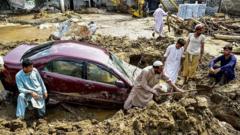How Many Are Missing in Pakistan's Flood-Hit District? Over 200 Disappear!

Devastating Monsoon Flooding and Landslides in North-West Pakistan
The recent monsoon season has wreaked havoc in north-west Pakistan, leaving over 200 people missing and claiming more than 300 lives across the region. The catastrophic flooding and landslides have primarily affected the mountainous Khyber Pakhtunkhwa province, with devastating consequences for the local population. As officials work tirelessly to rescue those trapped and provide relief to the affected communities, the implications of climate change loom large, raising questions about the future of this vulnerable region.
The Current Situation in Buner District
In the Buner district, which has been identified as one of the worst-hit areas, local officials report that at least 209 individuals are still unaccounted for. Jehangir Khan, a spokesman for Buner's deputy commissioner office, stated that rescue teams have already buried eight unidentified bodies, as no family members could be located to claim them. The destruction of roads due to severe flooding has further complicated the recovery efforts, leaving many families unable to reach the sites of their loved ones.
The Impact of Flash Floods
Flash floods are a common occurrence during the monsoon season in South Asia, which runs from June to September and delivers approximately three-quarters of the region's annual rainfall. However, this year has seen an alarming increase in both the intensity and frequency of these weather events, attributed largely to climate change. Asfandyar Khattak, head of the provincial disaster management authority, echoed concerns about the number of missing individuals, particularly in the nearby Shangla district.
Widespread Destruction
The devastation doesn't stop at loss of life; entire communities have been affected. Reports indicate that "10 to 12 entire villages" have been partially buried under landslides and debris. This widespread destruction has left many residents without homes or access to essential services. In addition to the loss of life, the economic impact will be significant, as local businesses and agricultural activities are disrupted.
Climate Change and Its Consequences
Climate scientists have warned that rising global temperatures are making monsoon-related disasters more severe. In northern Pakistan, where many glaciers are located, rapid glacial melt exacerbates the risk of landslides and flooding. As glaciers retreat, the potential for debris flow increases, leading to further instability in mountainous regions. This year, Punjab province, home to nearly half of Pakistan's population, recorded a shocking 73% increase in rainfall compared to the previous year, resulting in more fatalities than in the entire previous monsoon season.
The Role of Glacial Melt
Glaciologists suggest that the melting of glaciers is a significant contributor to the recent floods and landslides. As climate change accelerates glacial retreat, it destabilizes mountain faces, making them more susceptible to collapse. The combination of heavy rainfall and destabilized terrain creates a perilous environment for local communities, who are often ill-equipped to deal with such disasters.
Government Response and Future Outlook
In light of the ongoing crisis, local and national governments have declared several areas as disaster zones. Rescue teams are working around the clock to locate missing individuals and provide immediate relief to those affected by the floods. However, the challenges are immense. Infrastructure damage from landslides and floods complicates rescue efforts, and with heavy rainfall predicted to continue until 21 August, the situation may worsen before it improves.
Precautionary Measures Moving Forward
As the situation develops, it is crucial for both local authorities and the international community to take proactive measures to mitigate the impact of future disasters. Some recommended strategies include:
- Investment in infrastructure that can withstand extreme weather events.
- Implementation of early warning systems to alert communities about impending floods.
- Community education on disaster preparedness and response strategies.
- Strengthening environmental regulations to address the impacts of climate change.
Frequently Asked Questions
What causes floods during the monsoon season in Pakistan?
Monsoon rains, which occur from June to September, bring significant rainfall to the region. The combination of heavy rain and the geological characteristics of the area, such as mountainous terrain, can lead to flash floods and landslides.
How does climate change affect monsoon patterns?
Climate change is leading to increased temperatures, which can intensify monsoon rains and make them more unpredictable. This results in more severe flooding and landslides, affecting vulnerable communities.
What is being done to help the victims of the recent floods in Pakistan?
Local and national governments have initiated rescue operations and declared disaster zones in affected areas. Humanitarian organizations are also stepping in to provide relief and support to the displaced populations.
What long-term solutions are necessary to prevent future disasters?
Long-term strategies include investing in resilient infrastructure, implementing effective early warning systems, educating communities about disaster preparedness, and addressing the impacts of climate change through environmental regulations.
As the people of north-west Pakistan navigate the aftermath of this devastating monsoon season, one must reflect on the challenges they face and the broader implications of climate change. What steps can we take to support communities affected by such disasters and advocate for sustainable practices that protect our environment? #PakistanFloods #ClimateChange #DisasterManagement
Published: 2025-08-17 11:00:49 | Category: world



